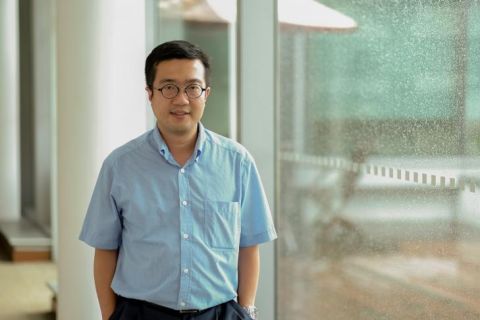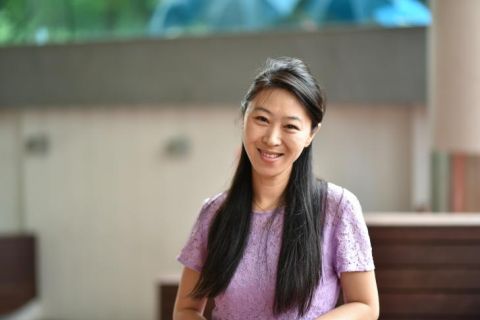
The Fujitsu-SMU Urban Computing and Engineering Corp. Lab is using technology to build cities free of taxi queues, congestion and crowding.

By Todd Andre
SMU Office of Research – It may not be as sexy as flying cars and hover boards, but getting home from work a little faster is definitely an enticing option. However, unless you have a train station next door or a highway nearby, taking a long commute and being stuck in traffic are likely to be the norm.
Imagine a Singapore where everyone enjoys top-notch transit services, and jams along expressways are alleviated because lorries and delivery trucks have been priced out of peak hour surcharges.
This is the future that the Fujitsu-Singapore Management University (SMU) Urban Computing and Engineering Corp. Lab (UNiCEN) seeks to build in five years without the need for high-cost infrastructure building.
Sounds impossible?
“It’s kind of a contradictory idea,” says Cheng Shih-Fen, associate professor at SMU and deputy director of UNiCEN, who advocates that the project is possible. “We are an island city with very limited space for infrastructure expansion, so what we want to achieve is to increase capacity without building more infrastructure.”
Infrastructure megaprojects like new subway lines and expressways take decades to plan and build, and with Singapore’s population expected to reach close to seven million by 2030, it must use existing technologies in novel ways.
UNiCEN’s S$27 million lab was launched in October 2014 and jointly funded by Fujitsu Limited and National Research Foundation under the Corporate Laboratory@University Scheme.
Apart from funding the lab, Fujitsu is providing its fast-processing machines which will provide the backbone that UNiCEN needs to build its technological platforms, as well as its expert team of scientists to assist in the research. Fujitsu will be a key technology provider for Tokyo’s 2020 Olympics, so the collaboration to create technologies to manage crowds during the games will be a core focus and challenge for the lab.
“It is less than five years away so we are really racing against time,” says Professor Lau Hoong Chuin, director of UNiCEN who expects the lab to produce crowd management testbeds and technologies by the time of the Olympics. “We do not just want to do paperwork based on theory, but we want to engineer software systems that governments, industries and societies can benefit from.”
The Sims: Suntec Convention Centre edition
One of UNiCEN’s key research areas is Dynamic Mobility Management (DMM), which studies citizens’ mobility-related needs and fulfilling them more efficiently by communicating through mobile apps.
For a start, UNiCEN is looking at creating a recommendation app for taxi drivers that will help them go where real-time demand is, in the hope of eliminating taxi queues. “We envision a future where passengers no longer have to wait for taxis in a queue,” says Professor Lau. “And by using our app, drivers will have mindful and direct access to where the customers are.”
Researchers at UNiCEN also plan to work with Suntec Convention Centre to find ways to improve visitor experience. For example, real-time location-based alerts on retail promotions or public transport service updates help attract convention visitors to visit the Suntec City mall, and avoid commuter crowds to optimise travel plans. Such services not only benefit businesses, but also create savings and a better overall experience for the visitors, while potentially easing train service and taxi congestion.
To do this, UNiCEN researchers are creating comprehensive computer models of the area and populating the area with “actors” who have personalities and goals. “Imagine if you put 20,000 of those individuals in a simulation model, each having their own consumption desires and needs,” says Professor Cheng.
After the model is built using data provided by the clients, the researchers then study how these actors move around in different scenarios, just like how one would control a family in the simulation video game series, The Sims.
“The real challenge here is to come up with a realistic model for visitor behaviours, taking into account practical considerations such as preferred ways and frequency of communication,” says Professor Cheng.
But the lab is going further than just building intelligent computer models. UNiCEN is going to use Singapore itself as its laboratory. Once the Sims-like computer modelling experiments turn up a reasonable solution, it is going to try them out in the real world and observe the results. “This is why Fujitsu invested in this centre; they want to see the real implications of the ideas we produce,” says Professor Cheng.
An eBay for freight traffic
Another arm of UNiCEN’s research is on Maritime, Port and Logistics Operations, the goal of which is to find ways to better regulate freight traffic from port to city.
Compared with Europe and Japan, Singapore is one of the few cities where the government has imposed little regulation on logistics, notes Professor Lau. For example, there are few limits on carbon emissions and how many freight trucks can be on the road at any given time, which have negative effects on urban sustainability.
Unfortunately, with rising e-commerce as well as a growing and ageing population, the situation will get worse before it gets better. “There will be more urban freight delivery activities in the future, which means more trucks will be moving on the road,” says Professor Lau.
There needs to be new technology to deal with both Business-to-Business (B2B) as well as Business-to-Consumer (B2C) last-mile logistics activities in the city, Professor Lau says. On B2B freight, UNiCEN’s idea is to encourage carriers to spread out delivery time and consolidate their cargo so there is a smaller urban logistics footprint.
Professor Lau wants to create a marketplace by building an eBay-style platform for freight traffic, so as to make it easier for shippers, retailers and logistics providers to collaborate with one another. This platform would help to optimise fulfilment operations and minimise social costs such as a large carbon footprint. The government will also be able to use the market platform as an instrument to regulate truck flow.
“At a high level, we want them to trade like a stock market with supply and demand, only that this involves physical delivery of items that have to be at some place by a given time to meet demands,” says Professor Lau.
Urban freight consolidation is already being practised in some cities in Europe. Like the Singapore government, Professor Lau wants to see it happen here. “We hope this would be a win-win mechanism for companies to get a fair share of their business, while contributing to environmental sustainability. We could change the landscape of logistics through innovative use of technology and economics principles. Collaborative urban logistics is the only way forward in a crowded city like Singapore,” he says.
The future is closer than we think
With big-budget infrastructure projects like the 3.5-kilometre Marine Coastal Expressway (MCE) ballooning in budget from an initial estimate of S$2.5 billion to S$4.1 billion, it is clear that digital technologies need to be harnessed to make what we already have a lot better.
If getting from point A to point B in the city quickly was once about the fastest highway or most intricate train network, it is now about which city can leverage on big data collected from cell phones, cabs, trains and freight to build a platform that will coordinate transport most efficiently. And the best part is, all of the technology and data that we need to orchestrate this Holy Grail is already here.
See More News
Want to see more of SMU Research?
Sign up for Research@SMU e-newslettter to know more about our research and research-related events!
If you would like to remove yourself from all our mailing list, please visit https://eservices.smu.edu.sg/internet/DNC/Default.aspx

